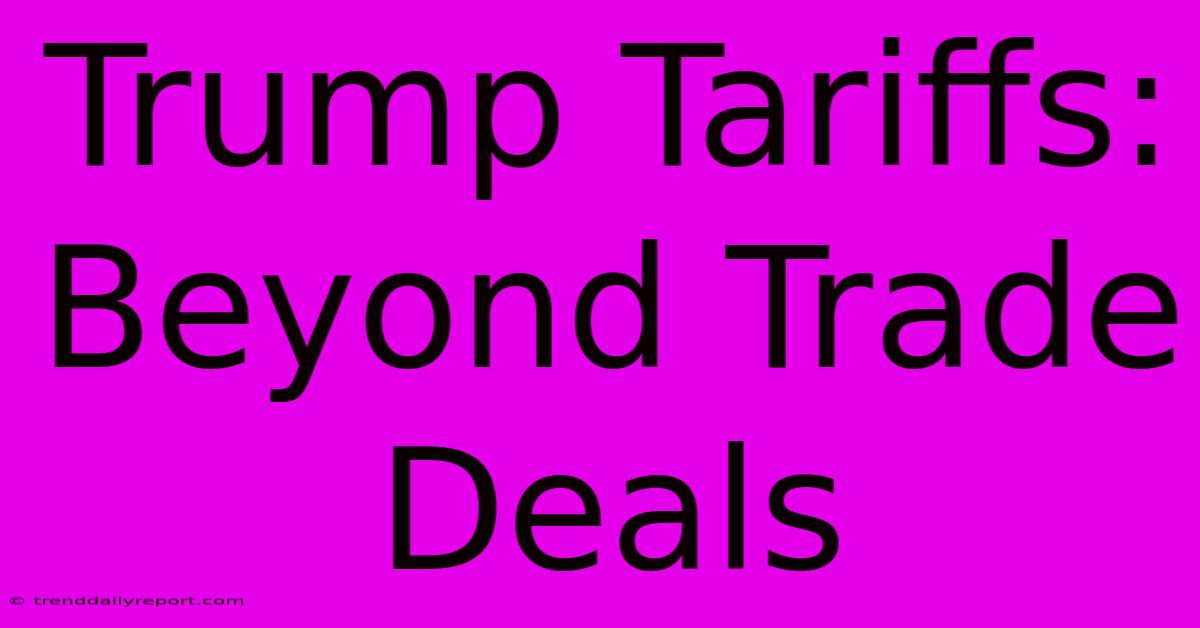Trump Tariffs: Beyond Trade Deals

Discover more detailed and exciting information on our website. Click the link below to start your adventure: Visit Best Website Trump Tariffs: Beyond Trade Deals. Don't miss out!
Table of Contents
Trump Tariffs: Beyond Trade Deals – A Ripple Effect Across Industries
Hey everyone, so we're diving into something pretty complex today: the impact of Trump-era tariffs. I know, I know, it sounds super boring, like something you'd only read about in a dusty economics textbook. But trust me, this stuff affects everyone, even if you don't think it does. It's way more than just trade deals; it’s about how stuff gets to your local store and what you actually pay for it.
My "Tariff-Induced" Kitchen Renovation Nightmare
Okay, so let me start with a personal anecdote. A few years back, I was finally getting around to that long-overdue kitchen remodel. I'd picked out these gorgeous, imported Italian cabinets – totally drool-worthy, right? Then, bam, the tariffs hit. Suddenly, the price jumped by, like, 20%! Twenty percent! That's a serious chunk of change, especially when you're already dealing with the crazy cost of kitchen renovations. I almost had a meltdown. Seriously, I almost canceled the whole thing. I ended up going with a different, slightly less fancy option, and let me tell you, it was a tough lesson learned.
The Bigger Picture: Beyond My Cabinets
My cabinet debacle was just a tiny example of the wider effects of these tariffs. They're not just about import taxes; they create a whole chain reaction that affects prices, supply chains, and even job markets. Think about it: if the cost of imported goods goes up, companies either raise prices for consumers or try to cut costs elsewhere – sometimes leading to layoffs or reduced quality. It's a domino effect, my friends.
Understanding the Impact: It's More Than Just Numbers
The impact of tariffs isn't limited to a single industry; it trickles down (or up, depending on how you look at it) across the entire economy. For example, tariffs on steel and aluminum impacted the automotive industry, raising the prices of cars and trucks. Then, that affected consumers' spending power, influencing other sectors. It's a complex web of interconnectedness.
- Inflation: Tariffs can contribute to inflation, as increased import costs are passed on to consumers. This directly impacts the cost of living, making everyday essentials more expensive.
- Supply Chain Disruptions: Tariffs can disrupt global supply chains, leading to shortages and delays. This is something we've all experienced in recent years – whether its a shortage of computer chips or a delay in getting a new appliance.
- Retaliation: When one country imposes tariffs, other countries often retaliate, leading to trade wars and further economic instability. This tit-for-tat can be pretty damaging to global trade relations.
Navigating the Complexities: Tips for Consumers and Businesses
So, what can we do? Well, it's not exactly easy to control global trade policy from our kitchen tables, but here are a few things to keep in mind:
- Diversify Suppliers: Businesses can mitigate some risks by diversifying their supply chains. Don't put all your eggs in one basket!
- Explore Domestic Alternatives: Where possible, prioritize goods made domestically to support local industries and reduce reliance on imports.
- Be Aware of Price Changes: Keep an eye on price fluctuations and understand how tariffs might impact the cost of the goods and services you buy.
Honestly, understanding the complete implications of these tariffs is tricky. I'm not an economist, and even experts disagree on the long-term effects. But the takeaway here is this: trade policy is never simple. It affects much more than just trade deals. It influences your wallet, the availability of products, and the overall economic climate. It's something to be aware of, and something to keep informed about. Next time you're shopping, maybe take a moment to think about where that product came from and what it might have cost to get it there. You never know what stories are hidden behind the price tag!

Thank you for visiting our website wich cover about Trump Tariffs: Beyond Trade Deals. We hope the information provided has been useful to you. Feel free to contact us if you have any questions or need further assistance. See you next time and dont miss to bookmark.
Featured Posts
-
Barcelonas Victory Player Ratings Breakdown
Nov 27, 2024
-
Score Bayern 1 0 Psg
Nov 27, 2024
-
Where Did Proper 12 Whiskey Go
Nov 27, 2024
-
Big Tony Tik Toker Death Mystery
Nov 27, 2024
-
Laos Arrests Impact Bowles Jones Families
Nov 27, 2024
